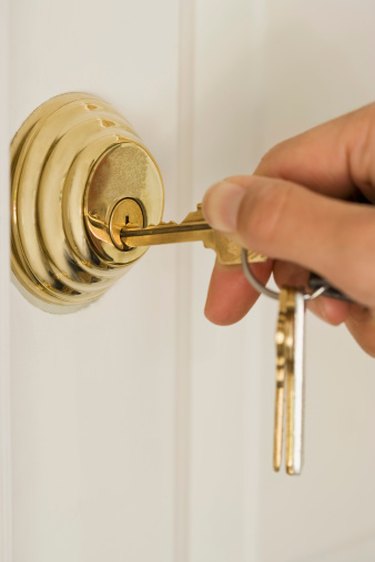
With the variety of key locks on the market today, it is important to identify what type of key lock you have, should it need to be replaced. Recognizing the types of key locks also helps in deciding which one is best for a particular purpose. You must observe the style of the lock, understand how it works and note how it is installed. One type may be best for locking a file cabinet, while another is best at securing the door to your home.
Step 1
Observe how the lock is fitted. Turn the key in the lock while you watch what happens. Push on the part that locks the door, window, drawer or cabinet to determine if it can be moved without the key. A lock that works by a thick piece that withdraws flush with the door when the key is turned one way and protrudes from the lock and cannot be pushed back by hand when the key is turned the opposite way is a deadbolt lock. Notice where the bolt is positioned to be able to lock the door. For most deadbolt locks, you will see a hole in the door frame with a piece of metal (referred to as a strike) that surrounds it.
Video of the Day
Step 2
Look at the end of the lock bolt. Observe whether it is level or beveled. Deadbolt locks have level ends. Attempt to close the door with the bolt extended in the locking position. A deadbolt doesn't move when it hits resistance. Latch-bolt locks have a beveled end to make automatic withdrawal easier while you close the door. Determine if your latch-bolt lock is equipped with a latch you can turn that causes the locked latch bolt to be immovable. Such a lock is a deadlocking latch bolt.
Step 3
Observe how the lock is fitted to the door. A lock with the mechanism installed fully inside the door through a rectangular cavity in the door's edge that requires inserting the key through a small opening in the side of the door in order to turn the deadbolt is a mortice lock. Deadbolt mortice locks provide a fair amount of security only if the door is strong.
Step 4
Observe whether the lock is installed on the surface and latches into a raised fitting mounted to one side of the frame. Locks of this type are rim locks and the raised fittings are called "keepers." There are many variations of rim locks including rim cylinder deadbolt latches, antique cast iron rim locks with door knobs and skeleton keys and lighter weight rim latches used to lock windows from the inside.
Step 5
Look at the shape of the lock. A cylindrical lock that fits through a hole with the keyhole on one side and the locking mechanism on the opposite side is a cam lock. Turn the key in the lock. The locking mechanism is a flat piece, frequently called a tailpiece, that moves to latch against the frame. This lock often is used for filing cabinets and desks.
Tip
Many variations and combinations of key locks exist. Read the key lock strike, check other surfaces for identifying information, measure openings and the distance between screws. Make drawings or take photographs before shopping for replacements if you are unsure of exactly what you need.
Video of the Day